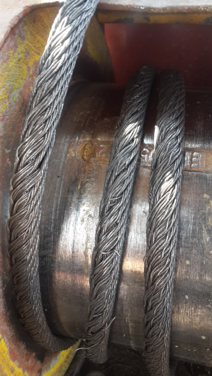Frequent Mistakes With SOPs
By Colin Rice · Colin Rice Exploration Drilling Advisory · www.colinrice.co.za
Over many years of doing safety audits on drilling operations, I frequently come across the same mistakes on site - missing SOPs.The risk assessment tells us when we need to develop an SOP and if the risk assessment is poor then not all hazardous activities will be identified and so we will miss some SOPs. Here are some examples from my experience…
Example 1: Wireline cable
We all know that wireline cable sometimes snaps and in some cases, the loose end of the cable will come off the sheave (pulley) at the top of the mast. Before we can splice or join the two broken ends of the wireline cable it is necessary that the cable is respooled over the sheave.
When I ask a driller or supervisor how they respool the cable most will immediately say that they lower the mast so that the sheave is at a lower height – they are forbidden to climb the mast and so the obvious answer must be that they will lower the mast. I then ask them how they do that when the drillstring is in the rod clamp and then they realise that they have talked themselves into a corner!
Sometimes they will then explain that they partially back a drill rod connection off and then lower the rods into the borehole and then fully back the connection off – effectively they leave the drillstring in the open hole. The more they explain their procedure the more holes can be poked through it because they have never in fact done what they say they do!
What really happens is that a member of the crew will climb up the mast and respool the cable. The crew will only do this when there is no danger of a safety officer being in the vicinity and so the principle of “ignorance is bliss” applies.
My argument is this: we all know that the wireline cable sometimes snaps and that it is sometimes necessary to respool it so, let us recognise that this is a hazardous operation and let us develop a really good procedure that ensures that all hazards are identified and controlled. The point is that this “dangerous” procedure must be disclosed to the mining company it must not be hidden or ignored.
Example 2: Overtight joints
Another example of a missing procedure that I frequently come across is “how to back-off an overtight joint”. Again, we all know that, for a number of reasons, a drill rod joint may become over-torqued while drilling and the only way that you can back-off a joint is to apply a greater torque in the opposite direction.
If the rod clamp and chuck cannot do the job, then the only other way is to use a wrench (Stilson or a rod wrench) and in extreme cases we use a cheater bar to create a mechanical advantage. For many mining companies the use of wrenches is forbidden and so how is the contractor going to back off the joint? Again, the driller will wait until there are no safety people around and he will use a wrench and cheater bar to back the joint off.
My argument is the same as in the previous example – we know that joints sometimes get over-torqued and we also know that there is only one way to back-off an over-torqued joint so let’s sit down and write a good, well structured procedure that addresses all of the risks involved.
To me this indicates a mature attitude to drill site safety – if we know what the risk is – we can manage it. If we don’t know what the risk is, it will bite us!!
SOPs are the most fundamental building block of a sound safety management system and they present primary evidence of the quality and maturity of a safety management system.
I believe that poor quality or missing SOPs indicates that the quality of the risk assessment was poor and so the drill will be operating with unidentified risk. It indicates that senior management have done a less than perfect job in designing and maintaining their safety management system.
It is important to recognise that it is a concern if an SOP is not in place but it may be infringement of the law if one is in place but it is not followed!

